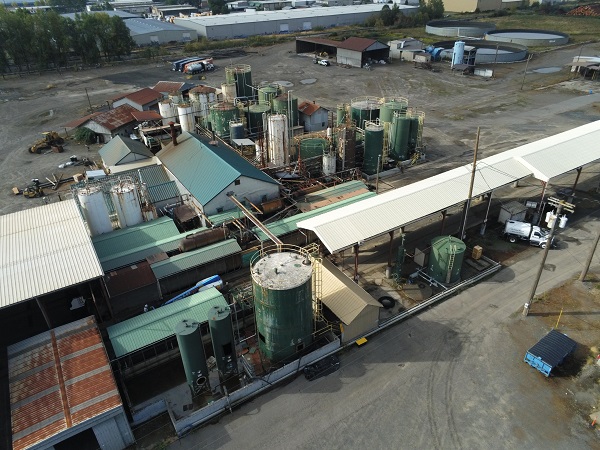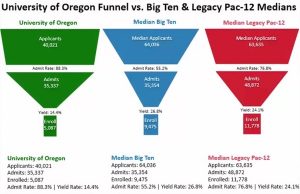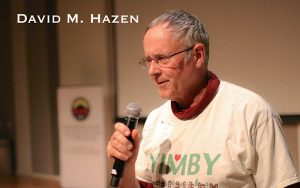Retired Bethel teacher: We smelled J.H. Baxter chemicals ‘all the time’
8 min read
Presenter: Our community reporter at the J.H. Baxter meeting July 16 is a retired Bethel teacher. For those who aren’t familiar with the J.H. Baxter saga, we asked why there’s a Superfund site in a Eugene neighborhood. Linda Duggan:
Linda Duggan (Retired Bethel teacher): I guess just some history with J.H. Baxter is that they treated wood with toxic chemicals, from what I understand, for the railroad. The chemicals they used were creosote, arsenic, and copper. They’re all toxic.
[00:00:36] So in 2008, DEQ started inspections. Baxter stopped production in 2022 and the site was full of chemicals, more than 65 tanks of chemicals. So anyway, DEQ got involved and then also LRAPA, EPA, OHA, and the Active Bethel Community and Beyond Toxics.
[00:01:09] I believe in August, 2024, EPA started doing what they call ‘time-sensitive removal action,’ and that’s when they actually went in there.
[00:01:25] Now, they didn’t mention some stuff at the meeting that I have gleaned from, I worked in that community, I have friends who live in that community, but apparently Baxter had released the chemicals into the air, like, at 1 a.m. thinking that, you know—
[00:01:48] We smelled it all the time. Those of us who worked there, those people who lived there, we smelled it all the time.
[00:01:54] And from some of the audience I found out, during and after the meeting mostly, that there were actually plumes that went way beyond Baxter area, all over the city.
[00:02:10] It’s more for me is that they didn’t do anything early. Somebody should have been monitoring that horrible toxic plant, and then it went on for too long. And then now what recourse do the people have that are sick? You know, what recourse do they have?
[00:02:33] But in the audience were people who were affected negatively. A woman’s five-year-old child has Hodgkin’s lymphoma. And she has to have cell transplants. She’s five years old.
[00:02:48] And another man has lived in the area decades and he has headaches every day. And he thinks he has more than that hasn’t really been found out yet.
[00:03:00] And I know personally, my friend who I worked with who lives in that neighborhood, there’s many wells there. And my friend, they didn’t use their well, they knew something was happening. They didn’t use their well, but neighbors of theirs did. They got leukemia.
[00:03:19] And when I was teaching at at least two of the schools, we were considered a ‘cancer cluster.’ We had many people with cancer, a couple died that I know of, and I’m a survivor.
[00:03:33] And the complaints at Fairfield from teachers when they were out at recess duty, saying the smell was so strong, and then there was a whole bunch of kids that got asthma.
[00:03:48] I smelled it every day. And I worked with people that got sick and died, and I had cancer. So, you know, that was why I went, as a former Bethel employee.
[00:04:00] So, you know, that’s just the tip of the iceberg. You know, I mean, it’s very serious. Currently Trainsong Park that has tons of kids that play there all the time—it’s contaminated. They don’t know if it’s from Baxter or where it’s from.
[00:04:21] Presenter: Linda noted that they called the event a celebration.
[00:04:25] Linda Duggan: They’re calling it a ‘celebration,’ which I think kind of had mixed feelings in the audience, celebrating that they’re cleaning it up and that it’s a Superfund site.
[00:04:41] But I can tell you from the start, during the celebration, I asked the questions: Who was supposed to be monitoring Baxter? No answer. Nobody had an answer. And: Why did it take so many years for anything to be done?
[00:05:04] Now, I do understand that there weren’t laws when Baxter started in 1943. So Baxter operated about 80 years. Eighty years, so I understand at the beginning there wasn’t anything, but it’s taken this long? But I was polite about it. But anyway, I know I had a lot of people feeling the same thing.
[00:05:32] The people that were there participating and speaking were the Active Bethel Community, which is a pretty strong organization in Bethel. They have a board and meet regularly. Sen. James Manning lives in Bethel and he also represents Bethel. And Randy Groves, who is the (city) councilor for Bethel area. DEQ was there. They had three or four people there. Only one spoke, I think it was only one, maybe two. And EPA was there.
[00:06:12] Now, it was interesting to me that Oregon Health Authority, OHA, was online, but they didn’t contribute at all. And we didn’t see people that were online.
And then people were allowed to ask questions, pretty much with each speaker. There weren’t always questions with each speaker, but there was, you know, time for that.
[00:06:37] So Baxter had more than 65 tanks of chemicals and the EPA went in in 2024 and we saw pictures of the cleanup and it was amazing. I mean, it was horrible, they had to deal with electrical was still on, all these tanks, contamination on the ground, under the ground.
[00:07:05] Presenter: They had to clean, then incinerate the inside of the tanks.
[00:07:09] Linda Duggan: So they remove the chemicals and they had to clean and cut up these tanks. I mean, they’re huge. So they had to cut ’em in parts, and clean them, and then they had to do asbestos abatement and they also had to go under the cement, under the containers.
[00:07:309] And then because it rains here, they had rainwater, 70,000 gallons that had to be cleaned, you know, part of the groundwater apparently. And all that waste of those tanks, etc., were taken to a place to be incinerated. It’s in Utah.
[00:07:50] The site is still contaminated, okay, they’re not finished, and that’s where the Superfund remedial process starts. So they will go in, and this is EPA again, they will do an assessment. They’ll do a characterization. They’ll set up a plan, a selection of remedy. They’ll do the cleanup, they’ll do the post construction, and then important key: redevelopment. So what they will be able to use that land for. And it’s a very large piece of land.
[00:08:28] And that just reminded me of conversation I had with some other people around me, after the meeting was that they’re selling houses and not telling the people of the contamination, they’re currently doing that and they have been doing that. That is a major, major problem.
[00:08:51] So all these people are very upset that they have bought these houses, or I’m sure renters too, that had no idea that it was contaminated.
[00:09:02] The EPA will also deal with soil and groundwater and stormwater on residential properties. And it was discussed (I brought it up) that there’s wells, well water, because that wasn’t on the list and they’ve only done, they’ve only examined very few of the yards that were directly by Baxter. So, you know, it’s going to entail a lot of area around that plant.
[00:09:44] And then I brought up a question about, ‘Well, you know, I think that the neighbors are the most important. You know, they’re living there 24-7, I said, but the businesses and people that work in the area, i.e. the schools, I said I had been a teacher, taught 28 years in Bethel.
[00:10:05] I think they’re only focused right now on the neighbors, the neighborhood. But I said, you know, ‘There’s people who work there every day. There’s business and there’s a lot of businesses around that area.’ And they hadn’t really put that into the plan, but they did say they would be doing the wells, and they now are informed about people working there.
[00:10:26] And then they also were going to look at the potentiality of water impact that migrated off-property. You know, so it might have run off, you know, with all our rain and, you know, kind of thing. And surface water. So they’re going to be looking at all that, the human health risk. They’re going to treat soils and groundwater and, you know, that’s where I brought up the wells. So they got that in there.
[00:10:57] So the next step is Community Action Plan: The Community Action Plan group with all those different agencies with (Active) Bethel Community and Beyond Toxics, they can get a technical assistance grant for $50,000 that’s available.
[00:11:17] They’re going to hold more community meetings. There is a group that’s supposed to be involved with people who got sick or died. And that’s really OHA, who wasn’t there, like I said, and supposedly they handed out door hangers, but it only was the immediate area next to Baxter, right.
[00:11:43] So there’s people in the audience that they didn’t get one, they haven’t been contacted by OHA and that’s why I said, you know, ‘It’s really a very large problem with people that live there and work there. Not just a block or two away from Baxter. Who knows how far?’
[00:12:03] They did give a website for updated information. It’s www.epa.gov/or/jh-baxter-superfund-site-Oregon.
[00:12:32] From what I understand, all the public health stuff is through the Oregon Health Authority, and they’re, I think, in Portland. I’m not quite sure how they’re going to become involved, but it’s definitely a big job. And the public health / environmental agency for toxic disease should be involved.
[00:12:57] They got the major stuff out of there and, I mean, you should have seen the hazmat suits were just covered with this brown stuff. Ugh. And I worry about them too. The people that have to clean it up and, and where the stuff went and, you know, all that.
And then a woman in the audience said, ‘Well, are you going to come into our houses to look at stuff?’ And they didn’t really respond. She said, ‘I have brown kind of stuff all around my. inside my light fixtures.’ And I’m sure she’s not the only one. But she spoke up.
[00:13:38] It was very informative. It feels good that they’re doing something finally, but there wasn’t much attention on the damage it’s already done to people’s lives. I mean, some people died. So that part was not part of the meeting.
[00:14:04] The speakers all did a very good job of giving the history and what’s going on. But the big part left out for me and for many people in the audience was the effect that this toxic pollution had on the people living and working in, and maybe beyond that area.
[00:14:27] And also, OHA they’re the primary agency that has to deal with that part. And they didn’t say anything. They didn’t speak.
[00:14:35] Presenter: She retired after 28 years in the Bethel schools, and this week Linda Duggan is our community reporter sharing an update on the J.H. Baxter Superfund site.
This story produced by John Q for KEPW Eugene PeaceWorks News, with support from listeners and readers in the Whole Community Time Bank, who encourage you to sign up for your own free personal account today.
Image of J.H. Baxter courtesy U.S. Environmental Protection Agency.




